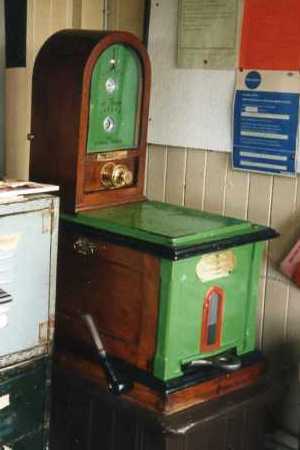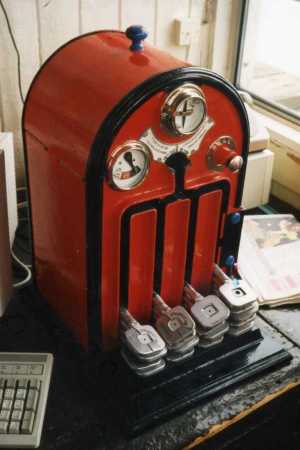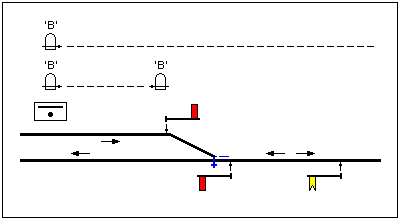|
|
|
Electric Token Block is a method of working for single lines that overcomes the inflexibility inherent in the more primitive systems such as Train Staff and Ticket, where there was only one staff for each section. The electric token system was designed by Edward Tyer and patented by him in 1878. After having been tested between Lockerbie and Lochmaben and later between Newmains and Morningside, the system was first put into everyday service in 1880 on the newly opened line between Dalmally and Oban.
The main advantage of the electric token system over the train staff system is the ability to obtain a token at whichever end of the single line section it is needed. Signalmen do not have to know beforehand the order in which trains are expected to pass through the section, which can change because of out of course running.
Tyer's original electric token instruments issued tokens in the form of flat metal discs known as tablets. In 1888, F W Webb and A M Thompson of the London & North Western Railway patented an electric train staff instrument, using tokens that retained the familiar shape of the staff. Tyer claimed in 1889 that this design infringed his own patent, and the LNWR agreed to pay him £2 for every instrument they produced. The Railway Signal Co. Ltd. produced a miniature electric staff instrument in 1906. The key token instrument, patented by A T Blackall and C M Jacobs of the Great Western Railway, was introduced by Tyer & Co. Ltd. in 1912. It became the preferred form of token instrument on Britain's railways, on account of it being very compact and mechanically simple, with few moving parts.

|

|
|
| Fig. 1: Tyer's No. 6 tablet instrument. | Fig. 2: Tyer's key token instrument. |
|---|
Figure 3 represents a typical single line section equipped with Electric Token Block.

|
| Fig. 3: Single Line Section with Electric Token Block. |
|---|
A quantity of tokens (typically thirty) are provided for each section. Apart from being individually numbered, all tokens for the same section are identical and are normally held in instruments at the extremities of the section, usually located inside signal boxes. The instruments are electrically interlocked so that only one token for the section can be out at any time. The tokens are inscribed with the name of the section that they apply to. Custody of a token is the driver's prime authority to occupy the section to which it refers and an assurance that no other train is in the section. The same tokens are used for train movements in either direction.
When all the tokens for the section are held in the instruments, the instruments are said to be 'in phase'. To allow a token to be obtained at the end where the train will enter the section, the signalman at the receiving end first presses the instrument's plunger to send current to the line. This energises the polarised electric lock (or relay) of the instrument at the sending end, allowing one token to be withdrawn. Withdrawal of a token from either instrument reverses the line polarity, putting both instruments 'out of phase'. It is not then possible to obtain a further token until the one that was withdrawn is inserted in the instrument at the opposite end of the section, putting both instruments back in phase. Except where the earlier designs of tablet instruments were used, a token could also be replaced into the instrument it was taken from. There is no lock on the insertion of tokens into an instrument.
Where a starting signal is provided that controls entry to the single line section, it would often be fitted with a mechanical or electric lock to prevent it from being cleared until a token for the section has been withdrawn.
A signal box will often contain token instruments for two or more different single line sections. To avoid the risk of a token being inserted into the wrong instrument (which might put them in phase while a train was in the section), tokens are given 'configurations'. Tokens belonging to adjoining sections always have different configurations. The configuration of a particular token can usually be readily identified by its colour or shape, or both.
An imbalance in train workings through a single line section can result in tokens accumulating in one instrument. The instruments may occasionally have to be balanced by maintenance staff who will remove excess tokens from the instrument at one end of the section and transfer them to the one at the opposite end. A portable magazine balancer, which can hold a number of tokens, may be provided to enable this procedure to be carried out in a secure manner. Tokens can be freely passed through an opening in the side of the instrument when the balancer is properly engaged. A token that is held in a balancer is not valid as authority for a train to occupy the single line section.
To facilitate easy exchange between signalman and traincrew, a token will usually be placed in a holder such as a leather pouch attached to a hoop. The hoop is wide enough to be caught by an outstretched arm. The pouch has a hole through which the driver can look to verify that it contains the correct token without having to remove it.
At some locations, token deliverers or receivers were fixed at the lineside so that the signalman did not need to be present at the moment when a train passed. The token was placed on the deliverer by the signalman and caught by the passing traincrew. The token being surrendered by the traincrew was caught by the arm of the receiver.
Automatic token exchange apparatus was devised to permit token exchanges to be performed at higher speeds and with less risk to personnel. This was first used in 1889 on the Great North of Scotland Railway. It required special apparatus to be fixed at the side of the railway and to the sides of locomotives. The holders containing the tokens to be exchanged were placed in the apparatus before the train arrived at the end of the section. This equipment is no longer used.
Since February 1987, the Rule Book has required that token exchanges are performed only while the train is stationary.
Where the start of the single line section is some distance from the signal box, auxiliary token instruments may be provided. Their provision avoids delay that would be caused by the time taken to deliver or return the token to or from the signal box on foot. The auxiliary instruments are of the same configuration as the corresponding section instruments but stand normally out of phase. When the signalman is ready to send a train into the section, a token is withdrawn from the main instrument in the usual manner. Instead of being handed to the traincrew, however, it is placed into the auxiliary instrument inside the signal box, putting both auxiliary instruments in phase. A token can then be obtained from the auxiliary instrument located at the entrance to the section. Conversely, auxiliary instruments can allow the token from an arriving train to be surrendered without the train having reached the signal box.

|
| Fig. 4: Auxiliary Instruments. |
|---|
Within a single line section, there may be a connection giving access to a siding. This will be worked from a ground frame that is released by the appropriate section token. If trains are required to 'shut in' at the siding, an intermediate token instrument will be provided near the ground frame. When the train requiring to shut in has cleared the running line, the token is inserted into the intermediate instrument to put the main instruments back in phase so that through running can be resumed. A local track circuit may be provided to prove that no vehicles have been left standing on the main line in the vicinity of the ground frame. Where only one train is required to shut in at a time, the intermediate instrument may be of the single-capacity type, capable of accepting just one token.
When the train is ready to depart the siding, the signalmen at both ends of the section will press the plunger on their token instruments at the same time, allowing a token held in the intermediate instrument to be released.

|
| Fig. 5: Intermediate Instrument (signals omitted). |
|---|
Under Electric Token Block, it is possible to arrange for a signal box to be able to switch out when not required; however, this is not so easily achieved compared with the Absolute Block system on a double track railway. It is not feasible to simply connect through the line wires of the adjoining sections, as their token instruments have different configurations. Instead, a separate pair of long section instruments has to be provided. The long section instruments must be of a different configuration from those of the corresponding short sections, as well as any adjacent sections. The long section instruments stand out of phase while normal short section working is in operation.
An arrangement is needed to switch between short and long section working and thus ensure that both cannot be available at the same time. When the signal box is switched out, the crossing loop points are locked so that one of the loops is used for through running by traffic in either direction. The locking of the relevant opposing signals is released, so that they can be simultaneously cleared for through running. Tablets for long section working were often square in shape.

|
| Fig. 6: Long Section Instruments (signals omitted). |
|---|
A key token instrument can be configured for 'no-signalman' operation, enabling it to be operated by the traincrew. The instruments at one end or both ends of a single line section can be of the 'no-signalman' type, depending on the circumstances. This method of working is called "No-Signalman Key Token" (NSKT). A typical application is a branch line with no signal box at the terminus end, where the pattern of train working calls for something more flexible than One Train Working.
The system known as No-Signalman Token Remote (NSTR) expands on the NSKT principle by having successive single line sections worked using traincrew-operated instruments, all under the supervision of one signal box.
|